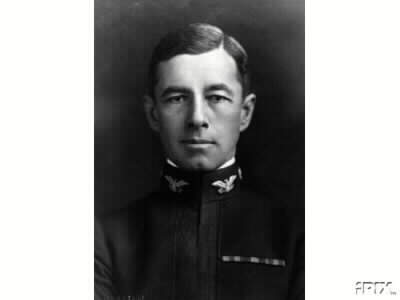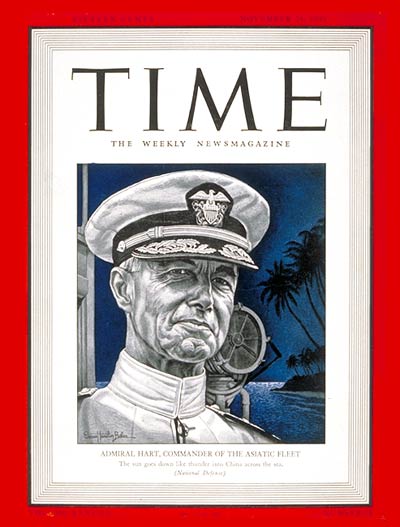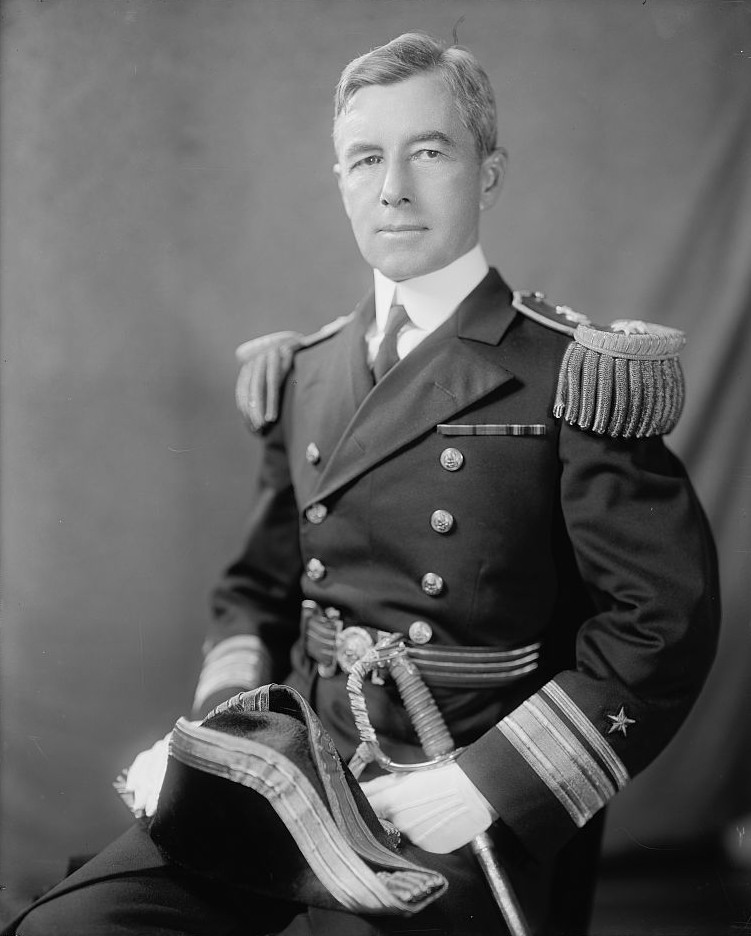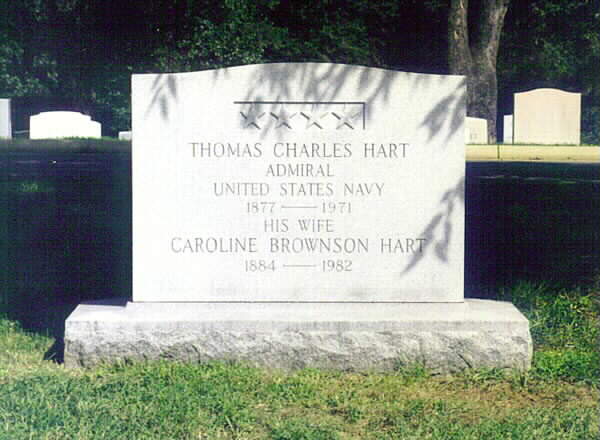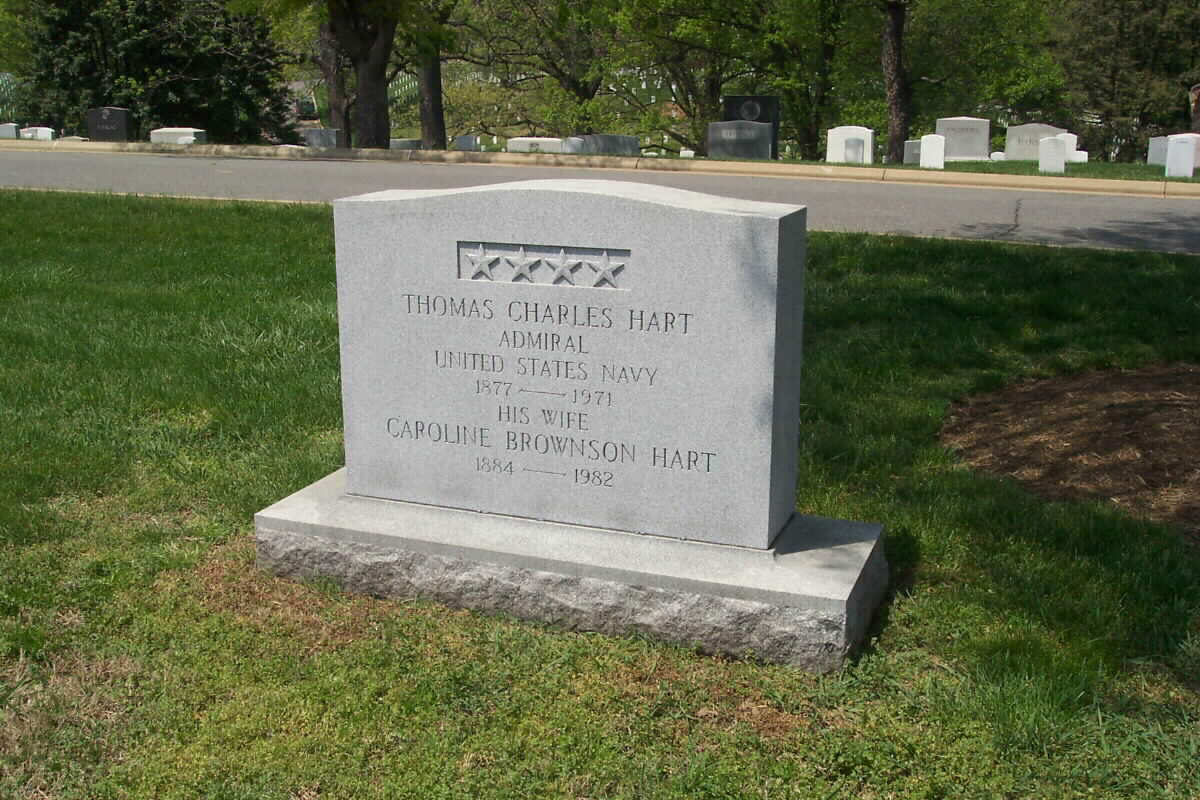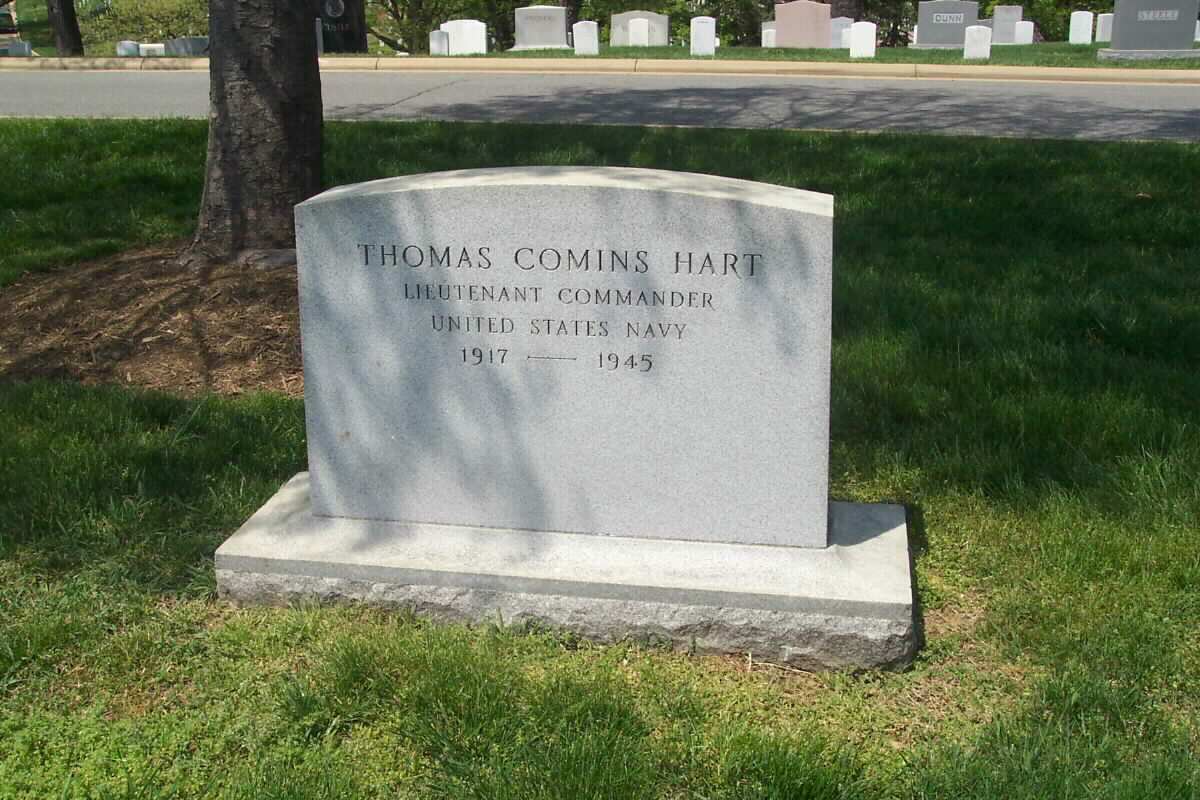Admiral Hart (Service No. 2387) was born on 12 June 1877 in Davison, Genesee County, Michigan, the son of John Mansfield Hart and Isabella Ramsey Hart. In 1897, he graduated 13th in his class of 47 from the U.S. Naval Academy, Annapolis, Maryland (Alumni No. 2273). He was commissioned in 1899. He graduated from the Naval War College in 1923 and from the Army War College in 1924. He was also a graduate of the Armed Forces Staff School and the National War College.
In 1898, during the Spanish-American War, he served in Cuban waters, as part of the blockade, aboard the messenger boat USS Vixen. During July 1898, along with Theodore Roosevelt, he fought in the Battle of Santiago.
Later in his career, he served as a Lieutenant and Division Officer aboard the Battleship, USS Missouri (BB-11) and as Commander of the torpedo boat destroyer, USS Lawrence (DD-8). He was qualified for Command of Submarines and during World War I, he was assigned as a commander of submarine operations in the Atlantic and Pacific Oceans as Director of Submarines at the Navy Department.
After World War I, he commanded the Battleship, USS Mississippi (BB-41) and later Submarine Divisions, Battle Fleet, and Submarine Force, U.S. Fleet. He was promoted to Rear Admiral in Sept 1929. From 1931 through 1934, he was the Superintendent of the U.S. Naval Academy.
He was promoted to Admiral in July 1939 and became Commander-in-Chief of the Asiatic Fleet. The USS Houston (CA-30) became Admiral Hart’s flagship on 19 November 1940. He remained aboard until 9 July 1941, when he shifted his flag to the yacht USS Isabel (PY-10). Admiral Hart was in Manila, Philippine Islands when the Japanese struck at Pearl Harbor, Hawaii on December 7, 1941. On 26 December 1941, two-days after General Douglas MacArthur left for Australia, Admiral Hart left Manila for Soerabaja, Java in the submarine USS Shark (SS-174).
The tense Far Eastern diplomatic situation finally degenerated into war, and in January 1942, although past retirement age, Admiral Hart became the Allied Naval Commander of the American-British-Dutch-Australian Forces (ABDA). After fighting a desperate defensive withdrawal, he was replaced, for political reasons, by Admiral C. E. L. Helfrich of the Dutch Navy. His command being obliterated in the subsequent naval operations, he was detached and retired in the rank of admiral in July 1942. He returned to active duty in Aug 1942 as a member of the U.S. Navy’s General Board and served as Chairman of the U.S. Navy’s Board of Awards until October 1942.
During 1942, from his farm in Connecticut, Admiral Hart wrote several articles for the Saturday Evening Post criticizing the United States’ preparations at Pearl Harbor prior to the Japanese attack there. In early 1944, he assisted in the study of the Pearl Harbor disaster.
In February 1945, he again retired from active duty to fill a vacancy, due to the death of the late Senator Francis T. Maloney, in the U.S. Senate from Connecticut. He was appointed by Governor Raymond Baldwin, a Republican. He did not run for election to a full term.
He returned to Sharon, Connecticut where he lived until his death at the age of 94 on 4 July 1971. Funeral services were held at the First Church of Christ Congregational in Sharon, Connecticut. On 8 July 1971, he was buried at Arlington National Cemetery, Arlington, Virginia (Section 8, Grave 5184-A). His wife is buried with him and his son, LieutenantCommander Hart, is buried nearby.
His awards include the Distinguished Service Medal (for World War I service), received from President Roosevelt a Gold Star in lieu of the Second Distinguished Service Medal, Spanish Campaign Medal, Sampson Medal with six bars, Mexican Service Medal, World War I Victory Medal with Submarine Clasp, China Service Medal, American Defense Service Medal with Fleet Clasp, Asiatic-Pacific Campaign Medal, American Campaign Medal, World War II Victory Medal, Order of the Orange-Nassau with sword by the Government of the Netherlands.
Admiral Hart was also honored with an honorary degree of Doctor of Laws from Wesleyan College in 1945.
He was married to Caroline Robinson Brownson Hart, daughter of the former Naval Academy Superintendent, Rear Admiral Willard H. Brownson. The farm where Admiral Hart lived in Sharon, Connecticut had been in the Brownson family since it was purchased from a member of George Washington’s staff in 1770.
His children: Lieutenant Commander Thomas Comins Hart (Class of 1939, U.S. Naval Academy, died of leukemia in 1945) commander of the USS Bullard (DD-660) during World War II; Roswell Roberts Hart (died in 1980) of Sharon, Connecticut; Harriet Taft Hart Sayre of Martha’s Vineyard, Massachueetts (wife of the Very Rev. Francis B. Sayre, Jr., the former Dean of Washington Cathedral); Caroline Brownson Hart Bergh (Mrs. Dana) of North Ferrisburg, Vermont; and, Isabella Hart Baldwin (Mrs. LaVerne) of Taconic, Connecticut.
The U.S. Navy honored Admiral Hart by naming a destroyer escort, the USS Thomas C. Hart (DE-1092) in his honor. The Thomas C. Hart was launched on 12 August 1972 and was sponsored by Penny Hart Bragonier (Mrs. Reginald), eldest granddaughter of Admiral Hart and daughter of Lieutenant Commander Hart. The ship was commissioned on 28 Jul 1973 and was the last combatant ship to be commissioned at the Boston Naval Shipyard. On 1 July 1975, the Thomas C. Hart was redesignated as a fast frigate (FF-1092).
The Thomas C. Hart was deployed during the Persian Gulf War as part of Operation Desert Shield/Storm. On 30 August 1993, she was decommissioned and leased to the government of Turkey. Since the end of the Cold War, the Thomas C. Hart and over 135 other former U.S. Navy and U.S. Coast Guard ships have been transferred to foreign governments.
Courtesy of the Congress of the United States
HART, Thomas Charles, a Senator from Connecticut; born in Davidson, Genesee County, Mich., June 12, 1877; attended various public schools in Michigan; graduated from the United States Naval Academy, Annapolis, Md., in 1897; served in the Regular Navy from graduation until 1945, when placed on the inactive list as an admiral (retired); his naval career covered service afloat during the Spanish-American War and both World Wars; upon retirement, settled in Sharon, Conn.; appointed as a Republican to the United States Senate to fill the vacancy caused by the death of Francis T. Maloney and served from February 15, 1945, to November 5, 1946; was not a candidate for election to the vacancy in 1946; resided in Sharon, Conn., until his death there on July 4, 1971; interment in Arlington National Cemetery, Fort Myer, Virginia.
Admiral Thomas Charles Hart
Born: 12 June 1877, Davison, Michigan
Died: 4 July 1971, Bethesda, Maryland
Nickname: „Tommy“, “Terrible Tommy”
Graduated U.S. Naval Academy with the Class of 1897, 12th in class. Posted as midshipman to battleship Massachusetts. Participated in her in the Battle of Santiago. Distinguished himself in action during scouting of Santiago de Cuba harbor and later invasion of Cuba. Then assigned to sailing sloop-of-war U.S.S. Hartford, spending two years aboard her. Then posted to the U.S. Naval Academy as instructor.
First ship command was destroyer Lawrence, whom he took over in December 1905. Relieved of command for disrespectful behavior in March 1907, he took a job in the Bureau of Ordnance. The letter of admonition for the above event was later removed. With a reputation in gunnery, he took office as gunnery officer on battleship Virginia in 1909. On March 30th, 1910, married Caroline Robinson Brownson.
Later in the same year, was posted to the Torpedo Factory at Newport, Rhode Island, as head of the division of Maintenance and Repair. Engineering being one of his fields of talent, Hart had the division under his control and going strong in little time. By December 1913, two children had been born to the Harts: Isabella and Roswell. With three years behind him at the Torpedo Factory, Hart was posted as executive officer to battleship Minnesota in Mexican waters. There, as concurrent Chief-of-Staff, Landing Force, Hart got initial diplomatic experience in dealing with local Mexican rebel/bandit groups.
February 1st, 1916, posted to the Third Submarine Division, Pacific Torpedo Flotilla, Pearl Harbor, Territory of Hawaii, as commander. The division was in thoroughly poor shape, so Hart took to utilizing his powers to make it work. When he left in 1917 to command the submarine base New London, he had put his division into fine shape.
Only two months were spent in New London, then Hart was ordered to take a division of K-class submarines across the Atlantic to aid Britain’s war effort against the submarine menace. From the Bantry Bay, Ireland, Hart commanded for a dull year, in which his submarines did not even so much as spot an enemy U-boat. Alas, it was okay service, and in August 1918, he was posted to the newly established office of the Chief of Naval Operations, were the Chief of Naval Operations, Admiral Benson, told him basically to “run the submarine service”. Without clear authority, Hart first took the anti-submarine operations away from the overworked Commander, Submarine Forces, Europe. On October 22nd, his role as Director of Submarines was formally affirmed, but twenty days later, the war ended, and Hart’s ability to control would be severely curtailed. Still, he had major influence on such subjects as submarine design and general policy.
In 1920, Hart took command of Submarine Flotilla Three, while a second daughter, Caroline, was born. Following that duty, in 1922, Hart was posted to the Naval War College for flag rank education. Graduating in May 1923, Hart went over to the Army War College, after finishing which course he was asked to remain for a year as instructor, a high honor.
In the spring of 1925, Hart was assigned as commanding officer to the battleship Mississippi. After this tour, which he considered his prime time yet, Hart was sent to take command of the torpedo station at Newport. Spending another two years there, in 1929, promoted Rear-Admiral, he was to take charge of Submarines, Battle Fleet, at Pearl Harbor. The senior submarine officer, Hart did only spend a year in Hawaii, from where, in 1930, he was sent to New London as overall commander of U.S. submarines.
In 1931, Hart became Superintendent of the Naval Academy, Annapolis, Maryland, a job which he quite liked and in which he became acquainted with Major-General Douglas MacArthur, then Army Chief-of-Staff. His first sea duty as a Rear-Admiral was as Commander, Cruiser Division 6, flag on Louisville, in mid-1934. He had been offered a battleship division, but preferred the possibilities of independent operations inherent in a cruiser command. He showed his talents: in Fleet Problem XVI, he probably executed the only air strike ever launched from cruisers when twelve of his floatplanes were sent to “bomb” the U.S. facilities and seaplane bases on Midway.
On 23rd January 1937, he was posted to the General Board, an advisory body to the CNO, which yielded some influence on ship design, but was usually a dead track for further advancement. It seemed an odd assignment for someone with five years before him until his mandatory retirement and with a service record as good as Hart’s.
That record was it that two years later made him eligible for the two prime spots in the Pacific theater: command, U.S. Fleet, or command, U.S. Asiatic Fleet. Washington prevented him from getting the U.S. fleet, but the Asiatic Fleet became his on 25th July 1939, taking over from Admiral Harry E. Yarnell. Hart was at the very peak of his career, settling into an atmosphere of tension. His fleet was there to show the flag in China, requiring extensive diplomatic abilities of its Commander-In-Chief. At the same time, Hart was determined not to let his force be understood as a showpiece. It was still a potent fighting force and Hart would not let it decay in matters of training and alertness.
Asiatic Fleet was spread throughout to the Far East. Destroyer divisions were stationed in Chinese waters, larger vessels came and went, and the main fleet base, Cavite, was in overall poor shape. With that support behind him, Hart had to navigate the treacherous waters of international intrigue, diplomatic handling of the warmongering Japanese, and all that while his forces were all but useless in combat.
Harts methods of improving their fighting potential was simple: training night and day under so real circumstances that nothing short of actual battle would yield as close results.
Diplomatic abilities were nothing if not needed in the Philippines. The local Philippine Army commander was Douglas MacArthur – Hart’s acquaintance from Annapolis, but very much an arrogant, self-serving and publicity-seeking person given to long tiresome monologues. Hart was one of the few people given to interrupting the General, something the latter did not quite like. As time progressed, however, Hart’s attitude towards MacArthur’s preposterous behavior declined until the two more merely cooperating, but not friends.
With war in Europe breaking out, Hart’s Asiatic Fleet became the only non-aligned force in the Far East. International settlements existed in Chinese ports, notably Shanghai, and Hart took it onto himself to ascertain that the conflagration on the old continent would not spread to Shanghai – were the Japanese would be pleased to jump in to “police” the Western powers and take their settlements away from them.
That Hart’s guess had been right was proven in May 1940 – after the unpleasant revelation that the Dutch had surrendered to the Germans (throwing Hart into doubts of the Dutch East Indies’ resistance capacities, something he needed to assess if he were to decide where to put his Asiatic Fleet in case of war), the French followed suit, and handed over their sector to the Japanese.
As the realities of war dawned on the United States, the search for Allies in Europe and the Far East left one prime player: Great Britain. The British, in the meantime, were no less certain that they needed help. They had already convened a meeting of representatives from Australia, New Zealand, the Netherlands, and themselves, to analyze their situation, and the American observer had been Hart’s Chief-of-Staff. But no affirmative response had been given to the British, on account of the American inability to word their own plans.
The new year 1941 finally brought these plans. Commander John L. McCrea brought Hart a copy of WPL-44, “Rainbow 3”, for comment. Hart was pleased: the plan suggest he would get a cruiser division, carrier, and destroyer squadron, a welcome addition to his weak force. But within the month, there came the unwelcome addition – there would be no reinforcements. And neither were there clear instructions for the case of war: Hart did not know what to do, for example, if the Japanese bypassed the Philippines and concentrated merely on the British and Dutch.
While Hart continued to plan for the event of war, in the summer of 1941, events indicated that war was imminent. Japan had occupied Indo-China; Malaya was now within the range of Japanese air power. And that war, it seemed, would yet be fought by Tom Hart: despite his reaching mandatory retirement age (64) that summer, the Navy intended him to keep his fleet. Meantime, MacArthur had been put into command of U.S. Army forces on the Philippines and was shaping bombastic plans for defense of the islands, throwing overboard what previous plans had determined to be the best course.
Despite that, Hart was quite confident he could hold his own. His physical examinations revealed him to be fit as a horse: “Will live to be 100 and have to be killed by an axe.” was Harts characteristically twinkling diary entry.
Increases in the Army’s air strength keep his spirits high as well. Dropping his earlier ideas of going south to the Dutch in case of war, Hart now intended to fight from the Philippines. Realizing the lack of firm commitments by the Dutch and British, it seemed to Hart that the offensive stance in the Philippines coupled with MacArthur’s boasting of being able to defeat the Japanese on land, would yield fine results. However, MacArthur served well to impede Hart’s ideas – he would not plan for reconnaisance missions to aid the Navy, nor would he allow the Navy to control his aircraft on reconnaissance missions over water. Instead, he took to insulting both Hart and his fleet. Without having track of MacArthur’s plannings, Hart could only plan for himself.
The first week of December 1941 finally brought news from the British. Admiral Sir Tom Phillips had brought his two battleships Prince of Wales and Repulse to Singapore and visited Hart in Manila. The two Admirals discussed plans for the event of war, now almost certain. Hart agreed to sending a division of destroyers down to Singapore to aid Phillips badly understrength command. When Phillips left on the afternoon of December 6th, Japanese forces had been sighted in the Gulf of Siam; Hart told Phillips that if the latter intended to see his ships again, he should leave immediately. That he did; he would die when Prince of Wales succumbed to Japanese air power on December 10th. On the evening of December 7th, Hart went off to see a movie downtown, then went to bed late. It would be a short night. Hart awoke at 3:30 on 8th December 1941 to listen to the news of the Pearl Harbor attack. It was not surprising that war broke out; but still, the timing was little better than terrible. Although his submarines were deployed, Hart’s surface units were still spread throughout the archipelago. And his plans for forward defense were crippled when MacArthur’s air force was riddled and blown up on Clark and Iba Fields. The same day that Admiral Phillips died on Prince of Wales, Cavite Navy Yard was bombed to pieces. With that, the last hope of defending the Philippines with anything more than PT-boats and submarines was lost.
Accordingly, the Asiatic Fleet was deployed south towards the Dutch East Indies, Hart leaving aboard submarine Shark on December 28 – five days after MacArthur had had to revert to the original war plans made for the defense of the Philippines, his vaunted forward defense having been ripped apart. Hart arrived at Surabaja, Java, on January 2nd. A day later, at the Dutch Governer-General’s mansion in Batavia, Hart received news that he had been selected for Commander, ABDAfloat, the naval forces of the new unified Allied command called ABDA (American-British-Dutch-Australian).
It was certainly not a great assignment. ABDAfloat numbered several cruisers, destroyers and submarines from four different nations, none of which (besides Australia and Britain) shared code books or signals. The ABDAfloat command was a hot-seat – defense of the vast Dutch colonial empire rested mainly on naval strength, but so did Japanese occupation power. If nothing else, the Allies would have to fight an enemy with vastly more power and far better common training. Still, it was obvious that sitting idle would not help the ABDA cause a bit, so Hart immediately acted to improve his own situation. With his staff constituted (of a British, Dutch, Australian and American officers) he started probing for the weak points in the Japanese thrust. On January 22nd, he won his first victory when a striking force of destroyers attacked the Japanese off Balikpapan and sank several Japanese transports. Hart’s elation over the victory was marred only days later when it became evident that the gain from this operation was negligible.
In Hart’s view, it was evident that ABDA was not capable of stopping the Japanese. He did not act defeatistly, but within the ABDA command structure, voices became loud claiming him incapable of working on – mainly Dutch voices. Surpreme Commander Wavell thought that Hart had “exaggerated ideas of Japanese effectiveness”. At home, President Roosevelt was not at all convinced that Hart was a good man for the job – personal animosity from past contact may have been part of the reason.
There had been little reason on practical grounds – Hart had conducted three strikes, two without contact and one resulting in the Balikpapan success. No-one could have done any better. On February 4th, he added another luckless mission which resulted in air-strike damage to cruisers Marblehead and Houston. The very next day, however, news from Washington arrived: Admiral King, ComInCh, had been ordered by the president to get Hart out of the war. King told Hart that he should ask for relief on medical reasons. Hart assented; the assignment with ABDA had not brought much but problems. It made Hart sad to leave the fine men of his command in a war zone while he headed home; but it could not be helped. He left Java on February 15th, and two weeks later, ABDAfloat was taken, broken in two, crushed, and shoved out of the way by the “overestimated” Japanese.
Back in Washington, instead of being retired, Hart was placed on the General Board again, for two years. In January 1944, he was sent to conduct an investigation on the causes of the Pearl Harbor disaster. Spending the better part of three months questioning witnesses both a Pearl Harbor and on the war fronts was very much to Hart’s liking. Back in Washington in April, in mid-summer he was called on by Admiral Stark to be his counsel in Stark’s appearance before the Court of Inquiry.
By the onset of 1945, it had become obvious to Hart that his career was over. His duties on the General Board had been reduced to almost nothing, with the general decline of that board.
However, his public live was not over. Governor Raymond E. Baldwin, [R, Connecticut], asked him if he wanted to fill the Senator term of Francis T. Maloney who had died in mid-January. That Republican seat Hart filled on February 15th, 1945, three years after he had given up ABDA command. He was a most unusual senator: he was more Republican than Democrat, but showed a rather bipartisan attitude. He did not vote Republican on foreign affairs, where he more often than not concurred with the Democrats.
As he served in the Senate, Hart was shattered to receive news of his son Thomas Jr.’s grave illness. He had been commanding a destroyer off Okinawa, and in July 1945, had been send to the west coast with a leukemia diagnosis. Hart and his wife arrived just in time to be with their son as he died. Leaving the Senate after a distinguished two years which left him with many friends and few enemies, Hart settled in Sharon, Connecticut, were he lived with his wife until his death. Tommy Hart died, July 4th, 1971, from a heart attack at age 94. It may be regarded as fitting that having spent fifty years in the service of his country, he passed on the birthday of the very nation he devoted his life to.
HART, THOMAS C
- ADM USN
- DATE OF BIRTH: 06/12/1877
- DATE OF DEATH: 07/04/1971
- BURIED AT: SECTION 8 SITE 5184-A R
ARLINGTON NATIONAL CEMETERY
Michael Robert Patterson was born in Arlington and is the son of a former officer of the US Army. So it was no wonder that sooner or later his interests drew him to American history and especially to American military history. Many of his articles can be found on renowned portals like the New York Times, Washingtonpost or Wikipedia.
Reviewed by: Michael Howard


